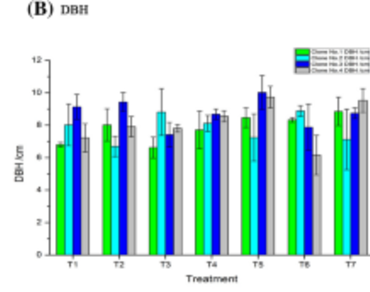The proportioning fertilization experiment on Betula alnoides
Chen Bihua, Jin Yajie, Zhang Juan, Chen Qinggen, Chen Cailing, Lin Yuqing, Liao Yinzhen, Jin Yajie
Research Articles | Published: 11 March, 2022
First Page: 649
Last Page: 655
Views: 3705
Keywords: n Betula alnoidesn , Clone, Fertilization, Urea, Potassium chloride, Calcium superphosphate
Abstract
In order to explore the best growth rate for the monocultured forest of Betula alnoides, the fertilization experiment was carried out in Wanshiqing area of Hua an Jinshan National Forest Farm. The experimental results showed that 250 g Calcium Superphosphate was optimal to use as basal fertilizer for B. alnoides reafforestation, and urea along with Potassium Chloride were used as topdressing, namely 50 g urea and 30 g Potassium Chloride were used as topdressing for first time of the first year, and for the second time, 100 g urea and 60 g Potassium Chloride were applied. In the second year, 100 g urea and 60 g Potassium Chloride were used as top dressing for the first time, and 150 g urea and 90 g Potassium Chloride were used for the second time. In the third year, 0 g urea and 90 g Potassium Chloride were used as topdressing for the first time, and 0 g urea and 0 g Potassium Chloride were used for the second time. 38 months after reafforestation, the average height, DBH and individual volume reached 6.76 m, 10.02 cm and 25.63 dm3, respectively.

References
Fan J, Gao Z, Cai Y, Lin R (2012) Forest site classification and site quality evaluation inFujian Province. For Prospect Design 1:1–5. http://www.cnki.com.cn/Article/CJFDTOTAL-LYKS201201002.htm
Liu S, Lin Chen B, Yang B, Jia H, Pang S, Zhang P, Wang H (2019) Effects of nitrogen and phosphorus fertilization on biomass allocation and root morphology in Betula alnoides clones. J Nanjing for Univ Natural Sci Ed 43(05):23–29. https://doi.org/10.3969/j.issn.1000-2006.201809018
Liu S, Chen L, Pang S, Zhang P, Yang B, Wei J, Jia H (2020) Effects of N and P fertilization on growth and leaf N and P contents of Betula alnoides clone plantlets. J South China Agric Univ 41(2):111–116. https://doi.org/10.7671/j.issn.1001-411X.201904005
Pang Z (2011) The study progress of Betula alnoides in China. J Guangxi Acad Sci 27(3):243–250. http://www.cnki.com.cn/Article/CJFDTOTAL-GXKX201103023.htm
Wang C, Zhao Z, Zeng J, Guo J, Sha E, Guo W, Zeng J, Zheng H (2013) Relationship between planting density and tree growth process of Betula alnoides Mid-young plantations in Pingxiang Guangxi. For Res 26(2):257–262. https://doi.org/10.13275/j.cnki.lykxyj.2013.02.020
Wang H, Zeng J, Luo B, Guo J, Wang C, Zhao Z, Zeng J (2017) Multiple-trait combined selection of superior Betula alnoides clones in eastern Guangdong. J Central South Univ for Technol 37(12):72–75. https://doi.org/10.14067/j.cnki.1673-923x.2017.12.012.html
Wang C, Tang C, Zhao Z, Guo J, Wang H, Wu L, Zeng J (2018) Growth response of mid-aged Betula alnoides plantations to thinning and fertilization in western Guangxi. J Central South Univ For Technol 38(05):28–32. https://doi.org/10.14067/j.cnki.1673-923x.2018.05.005. https://www.cnki.net/kcms/detail/detailall.aspx?dbcode=CJFQ&dbname=CJFDLAST2018&filename=ZNLB201805006
Yang G, Dao B, Yang C, Duan S, Huang G, Zhang R (2017). Preliminary study on fertilizationexperiment of young Betula alnoides in western Yunnan. For Sci Technol 2017(06):17–19. http://www.cnki.com.cn/Article/CJFDTOTAL-LYKT201706007.htm
Yunan Provincial Research Institute of Forestry Sciences (1985) Principal tree species afforestation techniques in Yunnan. Yunnan People’s Publishing House, Kunming, pp 123–125
Author Information
Fujian Academy of Forestry Sciences, Fuzhou, China